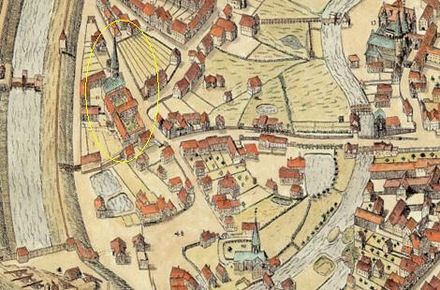Fraterhaus Munster

The Fraterhaus or Fraterherrenhaus in Münster was a settlement of the brothers from the common life . The convent was founded in 1401 from the original house in Deventer and was the first in what is now Germany. He had his seat in the southwest of the walled city in the house Zum Springborn ( lat. Ad fontem salientem ) on the west side of the Krummen Timpen between Bispinghof and today's Universitätsstraße . The community received its license to practice medicine from Pope Martin V in 1424 and existed until 1772.
history
The Broeders des gemeenen levens were a new kind of community in the “autumn of the Middle Ages” from the spirit of intensified personal piety ( Devotio moderna ), initiated by Geert Groote (1340–1384). They followed the ideal of the early Christian community of property , devoted themselves primarily to the production of books and ran schools. The starting point was the house in Deventer, founded around 1380. While the Windesheim monastery near Zwolle (founded in 1386) and its daughter monasteries in the Windesheim congregation were organized according to the Augustine rule, the foundations in Westphalia, on the Lower Rhine and in Lower Saxony, whose main initiator was Heinrich von Ahaus (around 1370–1439), continued for a long time a freer, non-monastic form of organization. Münster was the first of these.
Heinrich von Ahaus, who belonged to the cathedral clergy of Münster , came to the Deventer Brothers House in 1400 and enthusiastically joined the community. In 1401 he returned with some brothers to Münster, where a group of young clergy had asked the chaplain Johann von Steveren for help in founding a brothers' house. This took place solemnly on October 26, 1401. The community moved into the house at Zum Springborn on Honekamp (today Krummer Timpen ). In 1409 Heinrich von Ahaus took over the management; From 1416 to 1424 he stayed in Cologne to found another house . The connection between Münster and Cologne was the nucleus of the Münster Colloquium , in which in 1431 several Low German houses, including the Fraterhaus Herford , joined together to form a union of mutual support in external and internal affairs. The confessors of the Marienbrink sister house in Coesfeld were mostly members of the Münster Frater convention.
Since the community in Münster flourished and new brothers brought in their fortunes - foundations from outsiders were not accepted - the property and building were expanded in the course of the 15th century through acquisitions and extensions. After the end of the Anabaptist Empire in Münster in 1535, Prince-Bishop Franz von Waldeck temporarily took up quarters here. When the city , which was striving for autonomy , was defeated in 1661 , Christoph Bernhard von Galen made the Fraterhaus, which had been badly damaged in the previous battles, his inner-city residence and had it renovated accordingly. The brothers resisted, but had to limit themselves and received compensation payments from 1686. The house remained the residence of the episcopal sovereigns until the representative prince-bishop's palace was built on the site of the Münster Citadel at the end of the 18th century .
The Fraterherrenkonvent experienced a decline during this time; There were no new entries. In 1772 the chapter was formally abolished. The land and building were bought by the last treasurer of the prince-bishopric Clemens August Johann Nepomuk von Galen (1748–1820), who started his own building projects there from 1784. There have been no remains of the Fraterhaus since the beginning of the 19th century.
literature
- Gerhard Faix: Gabriel Biel and the brothers from the common life . Tübingen 1999, p. 10ff., P. 18ff. ( Partial digitization )
- Erwin Iserloh: Heinrich von Ahaus. In: New German Biography (NDB). Volume 8, Duncker & Humblot, Berlin 1969, ISBN 3-428-00189-3 , p. 405 ( digitized version ).
Web links
Individual evidence
- ↑ Germania Sacra , New Volume 37/1, 1999, p. 493 ( digitized version )
- ↑ from Latin frater - "brother"
- ↑ lwl.org ; In 1401, however , the Burgundian Netherlands belonged to the Holy Roman Empire , and there was no language border between Deventer and the Low German Münster , but a dialect continuum .
- ↑ a b lwl.org
- ^ Johan Huizinga
- ↑ a b Faix, p. 11
- ↑ Faix, p. 19
- ↑ Faix, p. 12
- ↑ lwl.org ; There is also a detailed description of the buildings and their use in the 18th century
- ↑ Germania Sacra, New Series 17/2, 1982, p. 750
- ↑ Germania Sacra, New Volume 37/1, 1999, p. 22
Coordinates: 51 ° 57 ′ 40.1 ″ N , 7 ° 37 ′ 7.2 ″ E